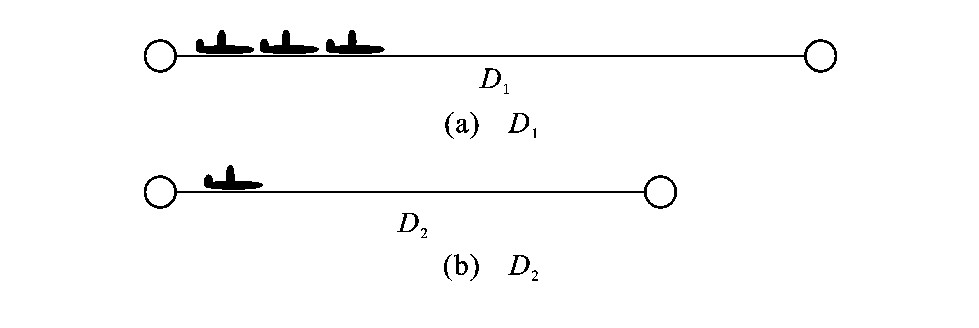-
摘要: 针对可接受航班编队调度优化问题, 从最大当量航程约束和最大允许延误约束出发, 推导出可接受编队模式的统计判别边界, 将编队调度优化问题转化为最优层次聚类问题, 利用改进的层次生长型自组织映射(GH-SOM)神经网络实现对可接受编队调度聚类的递归求精。仿真结果表明: 与经验判别边界相比, 基于可接受编队统计判别边界的识别量提高了92.14%, 平均扁率和平均时间同步偏差分别降低了25.00%和26.23%, 扁率标准差和时间同步偏差标准差分别降低了12.50%和18.75%;与自组织映射、标准GH-SOM相比, 基于改进GH-SOM的识别量分别提高了303.49%、162.87%, 平均扁率分别降低了34.25%、22.58%, 平均时间同步偏差分别降低了47.06%、36.62%, 扁率标准差分别降低了45.10%、6.67%, 时间同步偏差分别降低了46.94%、3.70%, 因此, 可接受编队模式的统计判别边界与改进GH-SOM是有效性的。Abstract: Aiming at the scheduling optimization problem of acceptable flight formation, the maximum equivalent range constraint and the maximum allowable delay time constraint were considered, and the statistical decision boundaries of acceptable formation pattern were derived.The formation scheduling optimization problem was transformed into the optimal hierarchical clustering problem, and an improved growing hierarchical self-organizing map(GH-SOM)neural network was used to realize the scheduling clustering recursive refinement of acceptable flight formation.Simulation result shows that compared with the empirical boundaries, the recognition quantity based on the statistical decision boundaries of acceptable formation increases by 92.14%, the mean flat rate and mean time synchronization deviation decrease by 25.00% and 26.23% respectively, and the standard deviations of flat rate and time synchronization deviation decrease by 12.50% and 18.75% respectively.Compared with self-organizing map(SOM)and standard GH-SOM, the recognition quantities based on the improved GH-SOM increase by 303.49% and 162.87% respectively, the mean flat rates decrease by 34.25% and 22.58% respectively, the mean time synchronization deviations decrease by 47.06% and 36.62% respectively, the standarddeviations of flat rates decrease by 45.10% and 6.67% respectively, and the standard deviations of time synchronization deviations decrease by 46.94% and 3.70% respectively.Therefore the statistical decision boundaries of acceptable formation pattern and the improved GH-SOM proposed in this paper are effective.
-
表 1 基于特征向量的识别结果对比
Table 1. Comparison of recognition results based on feature vectors

表 2 识别结果对比
Table 2. Comparison of recognition results

-
[1] DKM A. Global traffic forecast 2006-2025[R]. Montreal: Airports Council International, 2007. [2] ROJO J J. Future trends in local air quality impacts of aviation[D]. Cambridge: Massachusetts Institute of Technology, 2007. [3] DIJKERS H P A, VAN NUNEN R, BOS D A, et al. Integrated design of a long-haul commercial aircraft optimized for formation flying[C]∥AIAA. 11th AIAA Aviation Technology, Integration, and Operations(ATIO)Conference. Reston: AIAA, 2011: 1-8. [4] NING S A, FLANZER T C, KROO I M. Aerodynamic performance of extended formation flight[J]. Journal of Aircraft, 2011, 48(3): 855-865. doi: 10.2514/1.C031046 [5] NING S A. Aircraft drag reduction through extended formation flight[D]. Stanford: Stanford University, 2011. [6] NING S A, KROO I. Compressibility effects of extended formation flight[C]∥AIAA. 29th AIAA Applied Aerodynamics Conference. Reston: AIAA, 2011: 1-24. [7] FLANZER T C, BIENIAWSKI S R, BLAKE W B. Operational analysis for the formation flight for aerodynamic benefit program[C]∥AIAA. 52nd Aerospace Sciences Meeting. Reston: AIAA, 2014: 1-19. [8] XUE M, HORNBY G S. An analysis of the potential savings from using formation flight in the NAS[C]∥AIAA. AIAA Guidance, Navigation, and Control Conference 2012. Reston: AIAA, 2012: 1-12. [9] RIBICHINI G, FRAZZOLI E. Efficient coordination of multipleaircraft systems[C]∥IEEE. Proceedings of the 42nd IEEE Conference on Decision and Control. New York: IEEE, 2003: 1035-1040. [10] BOWER G C, FLANZER T C, KROO I M. Formation geometries and route optimization for commercial formation flight[C]∥AIAA. 27th AIAA Applied Aerodynamics Conference. Reston: AIAA, 2009: 1-18. [11] KENT T E, RICHARDS A G. A geometric approach to optimal routing for commercial formation flight[C]∥AIAA. AIAA Guidance, Navigation, and Control Conference 2012. Reston: AIAA, 2012: 13-29. [12] KENT T E, RICHARDS A G. On optimal routing for commercial formation flight[C]∥AIAA. AIAA Guidance, Navigation, and Control Conference 2013. Reston: AIAA, 2013: 1-11. [13] HINO T. Real time path planning method of aircraft formations[C]∥ICAS. 28th Congress of the International Council of the Aeronautical Sciences 2012. Stockholm: ICAS, 2012: 3391-3399. [14] XU J, NING S A, BOWER G, et al. Aircraft route optimization for formation flight[J]. Journal of Aircraft, 2014, 51(2): 490-501. doi: 10.2514/1.C032154 [15] DREZNER Z, WESOLOWSKY G O. Facility location on a sphere[J]. The Journal of the Operational Research Society, 1978, 29(10): 997-1004. doi: 10.1057/jors.1978.213 [16] 毛海军, 张永, 李旭宏. 物流企业分类模型[J]. 交通运输工程学报, 2005, 5(2): 117-121. http://transport.chd.edu.cn/article/id/200502028MAO Hai-jun, ZHANG Yong, LI Xu-hong. Logistics enterprise classifying model[J]. Journal of Traffic and Transportation Engineering, 2005, 5(2): 117-121. (in Chinese). http://transport.chd.edu.cn/article/id/200502028 [17] KOHONEN T, KASKI S, LAGUS K, et al. Self organization of a massive document collection[J]. IEEE Transactions on Neural Networks, 2000, 11(3): 574-585. doi: 10.1109/72.846729 [18] FRITZKE B. Growing grid—a self-organizing network with constant neighborhood range and adaptation strength[J]. Neural Processing Letters, 1995, 2(5): 9-13. doi: 10.1007/BF02332159 [19] FRITZKE B. Growing cell structures—a self-organizing network for unsupervised and supervised learning[J]. Neural Networks, 1994, 7(9): 1441-1460. doi: 10.1016/0893-6080(94)90091-4 [20] MIIKKULAINEN R. Script recognition with hierarchical feature maps[J]. Connection Science, 1990, 2(1/2): 83-101. [21] DITTENBACH M, MERKL D, RAUBER A. The growing hierarchical self-organizing map[C]∥IEEE. Proceedings of the International Joint Conference on Neural Networks. New York: IEEE, 2000: 15-19. [22] DITTENBACH M, RAUBER A, MERKL D. Uncovering hierarchical structure in data using the growing hierarchical self-organizing map[J]. Neurocomputing, 2002, 48(1-4): 199-216. doi: 10.1016/S0925-2312(01)00655-5 [23] BLAKE W, MULTHOPP D. Design, performance and modeling considerations for close formation flight[C]∥AIAA. 23rd Atmospheric Flight Mechanics Conference. Reston: AIAA, 1998: 476-486. -





 下载:
下载:










